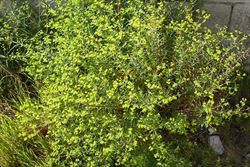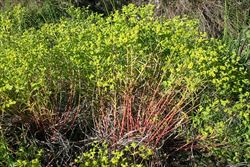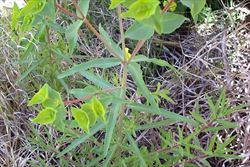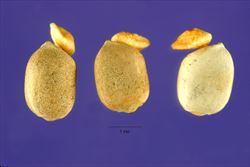Click on images to enlarge

habit (Photo: Sheldon Navie)

habit showing numerous reddish-coloured stems (Photo: Sheldon Navie)

elongated greenish lower leaves and broader yellowish upper leaves on flowering branches (Photo: Sheldon Navie)

upper leaves and immature fruit (Photo: Sheldon Navie)

close-up of stems and upper leaves (Photo: Sheldon Navie)

close-up of seeds (Photo: Carole Ritchie at USDA PLANTS Database)

young plant (Photo: Sheldon Navie)
Scientific Name
Euphorbia terracina L.
Family
Euphorbiaceae
Common Names
false caper, Geraldton carnation spurge, Geraldton carnation weed, terracina spurge
Origin
Native to the Mediterranean region (i.e. Algeria, Egypt, Morocco and Tunisia in northern Africa; Albania, Greece, Italy, Yugoslavia, France, Portugal and Spain in southern Europe; and Cyprus, Jordan, Lebanon, Syria and Turkey in western Asia).
Naturalised Distribution
This species is widely naturalised in southern Australia. It is most common in the coastal districts of south-western, western and southern Western Australia and in south-eastern South Australia. It is also naturalised in some parts of Victoria and western New South Wales.
Habitat
False caper (Euphorbia terracina) is mostly found in temperate and semi-arid regions. It infests pastures, roadsides, gardens, open woodlands, waterways, disturbed sites, waste areas, crops and coastal sand dunes.
Habit
An upright (i.e. erect or ascending) and long-lived (i.e. perennial) herbaceous plant growing to about 1 m tall. It produces several to numerous short-lived stems each year from a long-lived crown at ground level.
Distinguishing Features
- this herbaceous plant has a long-lived basal crown from which arises several upright stems up to 1 m tall.
- its stems are often reddish in colour, particularly near the base of the plant, and contain copious amounts of milky sap.
- its leaves are narrow, alternately arranged, and bright green along the stems.
- near the tops of each stem is a cluster of several leaves, above which several flowering branches are produced.
- these flowering branches have paired leaves that are shorter, broader and yellowish-green in colour.
- its inconspicuous greenish or yellowish 'flowers' are borne at the tips of these branches and have a large ovary that develops into a three-sided capsule (3-5 mm long and 4-5 mm wide).
Stems and Leaves
The stems are green to reddish in colour, especially near the base of the plant, and hairless (i.e. glabrous). They are unbranched for most of their length, but split into four or five small branches above a cluster (i.e. whorl) of leaves. These small branches give rise to the flowering stems at the very top of the plant. The stems and leaves contain copious amounts of milky sap (i.e. latex).
The hairless (i.e. glabrous) leaves are bright green or bluish-green along the stems, but those at the tips of the flowering branches are usually yellowish-green in colour. The leaves along the lower parts of the stem are alternately arranged, stalkless (i.e. sessile), and narrow in shape (10-40 mm long and 2-8 mm wide). However, the uppermost leaves on the flowering branches are oppositely arranged, often with finely toothed (i.e. serrulate) margins, and are shorter and broader (10-30 mm wide) than the lower leaves (occasionally these leaves are almost triangular in shape).
Flowers and Fruit
The inconspicuous 'flowers' (i.e. cyathia) are actually cup-like structures (i.e. involucres) containing several tiny male flowers and one female flower. The male flowers are reduced to stamens, while the female flower consists of a large stalked ovary topped with a stigma. These 'flowers' (i.e. cyathia) are borne singly, or occasionally in twos or threes, near the tips of the branches, but may appear to be arranged in branched leafy clusters at first glance. They are green, yellowish-green or yellow in colour and their cup-like structures (i.e. involucres) are fringed with several tiny, slender projections. Flowering occurs mostly during spring and summer.
The fruit is a drooping (i.e. pendulous) three-lobed capsule (3-5 mm long and 4-5 mm wide). These capsules contain several grey or mottled (i.e. grey with brown or black patches) seeds that are about 2-2.5 mm long.
Reproduction and Dispersal
This species reproduces by seed. These seeds are explosively released from the mature capsules, spreading them over short distances. Longer distance dispersal is mostly aided by water, animals, machinery and in mud or contaminated agricultural produce.
Environmental Impact
False caper (Euphorbia terracina) is regarded as an environmental weed in Western Australia, South Australia and Victoria, and it is listed as a priority environmental weed in three Natural Resource Management regions. This plant forms dense thickets which out-compete native species for space, light and nutrients. Its rapid growth and prolific seeding enables it to invade areas of healthy bushland, coastal sites, riparian areas and open woodlands.
False caper (Euphorbia terracina) is probably of most concern in south-western Western Australia, from Geraldton to Esperance, where it is generally known as Geraldton carnation weed. It is listed as a high priority weed in Environmental Weed Strategy of Western Australia and is actively managed by community groups in this state. This species is predominantly found in coastal heathlands and tuart woodlands in Western Australia, but is also problematic in wetlands (e.g. Paganoni Swamp) and waterways (e.g. it is listed as a common invasive weed species in Melville City and Perth waterways). False caper (Euphorbia terracina) is also becoming an increasing problem in the Swan Natural Resource Management region and is listed as one of the top ten coastal weeds in the Central West Coast and South Coast regions of Western Australia. It has been recorded from numerous conservation areas in this state (e.g. Utcha Swamp Nature Reserve, Numbung National Park, Nilgen Nature Reserve, Yanchep National Park, Tuart Forest National Park, Yalgorup National Park, Leeuwin Naturaliste National Park, Crampton Nature Reserve and Alfred Cove Nature Reserve) .
In South Australia the main populations of false caper (Euphorbia terracina) extend from the Yorke Peninsula north to Gawler and along the Murray River, and the south-east coast, to the Victorian border. It is common on sand dunes, along roadsides and in degraded bushland, and is often associated with shallow soils that have a high calcium carbonate content. When growing in coastal sites, this species generally occupies the mid and rear dune areas where the environment is less saline and more protected from harsh conditions. It is particularly prolific in sheltered areas in the dunes of sheltered coasts and gulfs. False caper (Euphorbia terracina) is also present in numerous conservation areas in this state (e.g. Marino Conservation Park, Moana Sands Conservation Park, Hallett Cove Conservation Park, Semaphore Park Coastal Reserve, Onkaparinga River National Park, Cleland Conservation Park, Sturt Gorge Recreation Park and the Henley South and West Beach Dune Reserve). Significant populations of this species are also present in north-western Victoria and smaller populations are located in inland New South Wales.
Other Impacts
This plant is poisonous to humans and is suspected of causing hydrogen cyanide poisoning in livestock. Its milky sap can also cause skin and eye irritation.
Legislation
This species is declared under legislation in the following states and territories:
- South Australia: 2@ - this species is declared under Class 2k, which is a classification for existing agricultural weeds. It is declared, and its control is required, throughout the entire state.
- Western Australia: Prohibited - on the prohibited species list and not permitted entry into the state.
Management
For information on the management of this species see the following resources:
- the Environmental Weeds Action Network brochure on this species, which is available online at http://members.iinet.net.au/~ewan/gcw.pdf.
Similar Species
False caper (Euphorbia terracina) may be confused with several of the weedy spurges (Euphorbia spp.), including caper spurge (Euphorbia lathyris), sun spurge (Euphorbia helioscopia), sea spurge (Euphorbia paralias) and petty spurge (Euphorbia peplus). These species can be distinguished by the following differences:
- false caper (Euphorbia terracina) is a relatively large and long-lived (i.e. perennial) herb (20-120 cm tall) with several to numerous stems being produced from near the base of the plant. The lower parts of these stems have relatively small (10-40 mm long) and narrow (i.e. linear or lanceolate) leaves that are alternately arranged.
- caper spurge (Euphorbia lathyris) is a relatively large and short-lived (i.e. annual or biennial) herb (50-150 cm tall) that usually has a single robust main stem. The lower parts of this stem have relatively large (50-160 mm long) and narrow (i.e. linear or oblong) leaves that are oppositely arranged.
- sun spurge (Euphorbia helioscopia) is a relatively small and short-lived (i.e. annual) herb (up to 50 cm tall) with one or occasionally more main stems being produced from near the base of the plant. The lower parts of these stems have relatively small (10-40 mm long) and egg-shaped (i.e. ovate) or spoon-shaped (i.e. spathulate) leaves that are alternately arranged.
- sea spurge (Euphorbia paralias) is a relatively small and long-lived (i.e. perennial) herb (20-70 cm tall) with one to several main stems being produced from near the base of the plant. The lower parts of these stems have small (5-20 mm long) and relatively narrow (i.e. elongated, oblong or elliptic) overlapping leaves that are somewhat fleshy.
- petty spurge (Euphorbia peplus) is a small and short-lived (i.e. annual) herb (up to 40 cm tall) that usually has a single main stem. The lower parts of this stem have small (5-25 mm long) and egg-shaped (i.e. ovate) leaves that are alternately arranged.

